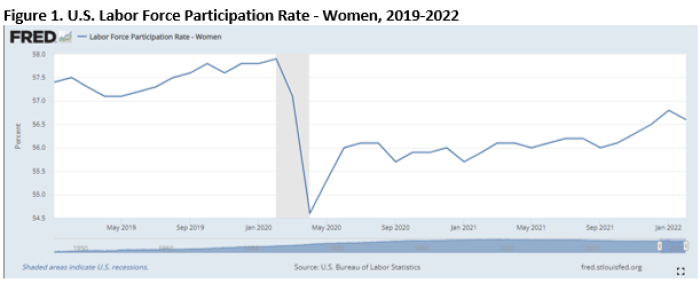 Southwest Minnesota is a national leader in agricultural production, and renewable energy.
Southwest Minnesota is a national leader in agricultural production, and renewable energy.
The region's thriving manufacturing sector includes food processing, machinery, printing, metal products, and computers and electronic products.
Want the freshest data delivered by email? Subscribe to our regional newsletters.
3/11/2022 9:00:00 AM
Luke Greiner
Prior to the pandemic, there were just under 100,000 female workers in the labor force in Southwest Minnesota, accounting for almost 47% of the total workforce in the region. Interestingly, the number of females aged 16 years and over was higher than for males, but the male labor force participation rate checked in at 72.8% compared to 63.1% for females, leading to about 14,000 more male workers than female.
The cause of the discrepancy between male and female labor force participation is likely due in large part to women taking on more child raising responsibilities, as demonstrated by rates for different age groups.
For example, female teenagers and young adults were more likely to be participating in the labor force than males from 16 to 24 years of age in the region, with both females and males each accounting for about 19,000 young workers in the region.
But for people in their prime working years from 25 to 54 – which are also the prime childbearing and rearing years – participation rates were more than 8.3% lower for females than males. Rates stayed lower for females from 55 to 74 years as well. And perhaps the biggest difference is in the oldest age group – with females outnumbering males by nearly 6,500 people, but with a labor force participation rate that was less than half as high as for males (see Table 1).
Table 1. Southwest Minnesota Employment Characteristics |
Minnesota | |||
|---|---|---|---|---|
| By Gender, 2019 | Total Population | In Labor Force | Labor Force Participation Rate | Labor Force Participation Rate |
| Male, 16 years & over | 155,518 | 113,204 | 72.8% | 73.5% |
| 16 to 19 years | 11,070 | 6,300 | 56.9% | 50.1% |
| 20 to 24 years | 14,827 | 12,453 | 84.0% | 84.0% |
| 25 to 44 years | 46,370 | 43,194 | 93.2% | 92.3% |
| 45 to 54 years | 23,097 | 20,739 | 89.8% | 90.5% |
| 55 to 64 years | 27,319 | 21,786 | 79.7% | 76.5% |
| 65 to 74 years | 18,509 | 7,059 | 38.1% | 31.8% |
| 75 years & over | 14,326 | 1,673 | 11.7% | 9.2% |
| Female, 16 years & over | 156,960 | 99,106 | 63.1% | 65.9% |
| 16 to 19 years | 10,728 | 6,411 | 59.8% | 56.4% |
| 20 to 24 years | 14,866 | 12,630 | 85.0% | 85.2% |
| 25 to 44 years | 42,981 | 35,960 | 83.7% | 85.1% |
| 45 to 54 years | 22,157 | 18,575 | 83.8% | 84.6% |
| 55 to 64 years | 26,642 | 19,591 | 73.5% | 69.7% |
| 65 to 74 years | 18,857 | 4,966 | 26.3% | 24.3% |
| 75 years & over | 20,729 | 973 | 4.7% | 4.7% |
| Source: 2015-2019 American Community Survey, 5-Year Estimates | ||||
Even though their labor force participation rates were lower than for males, the number of female workers had been increasing over time as the region's population continued to increase. While we do not have details at the regional level yet, U.S. and statewide data show that labor force participation rates for both males and females have fallen since the onset of the COVID-19 pandemic, but most notably for females. Nationally, the female labor force participation rate dropped from 57.9% in February of 2020 to a low of 54.6% in April of 2020, before climbing back to 56.6% in February of 2022 (see Figure 1). For males, it started at 69.3% but has bounced back to 68.3%, down just -1.0% from pre-pandemic levels.
Figure 1. U.S. Labor Force Participation Rate - Females, 2019-2022

At the state level, our alternative measures of unemployment show a 12-month rolling average of 63.6% female labor force participation in December of 2021, compared to 66.2% in February of 2020, prior to the impact of the pandemic. Rates also dropped for males in Minnesota, from 73.9% in February 2020 to 71.8% in December of 2021. In both cases, the decline was more severe for females than for males.
If female labor force participation rates declined the same amount in Southwest Minnesota as the state overall, that would equal the loss of 4,145 female workers in 2021 compared to 2019. That is a significant loss of workers for a region that was already struggling with a tight labor force against rising job vacancies.
The reasons for the workforce challenges are varied, but include difficulties with child care, elder care, and other family responsibilities; more layoffs and a slower initial recovery from pandemic-related losses in industries that have more female workers – such as Health Care & Social Assistance, Accommodation & Food Services, Other Services, Educational Services, and Arts, Entertainment & Recreation – and faster than expected retirements among the older population.
Contact Labor Market Analysts Luke Greiner at 320-308-5378 or Mark Schultz.